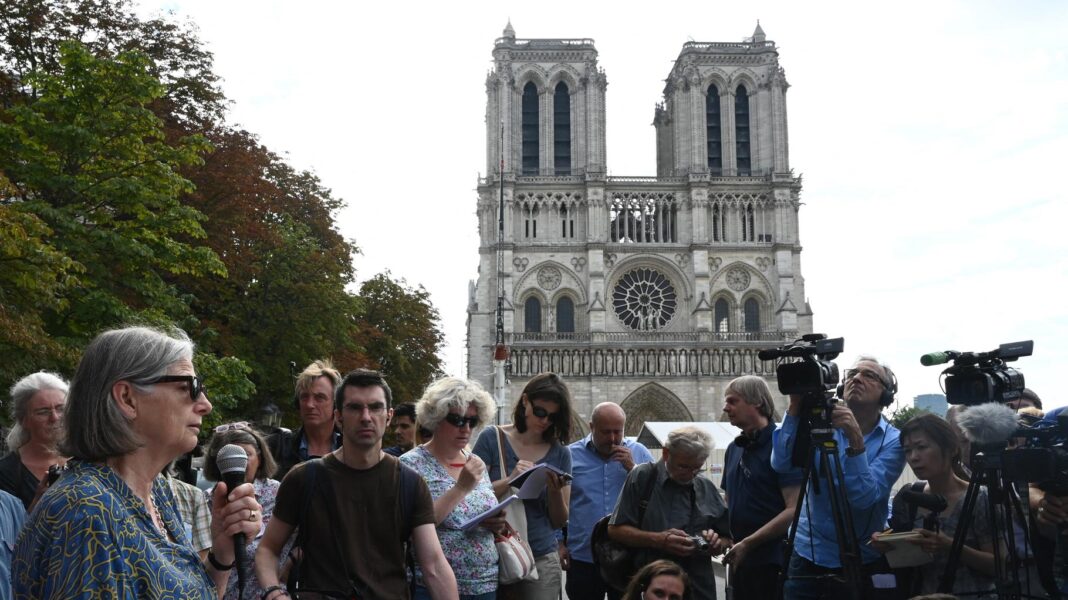Uncovering the Truth Behind Notre-Dame: A Revealing Review
As the flames engulfed the iconic Notre-Dame Cathedral, a cloud of toxic lead particles descended upon the people of Paris. In the aftermath, a controversial decision was made to reconstruct the cathedral using traditional lead materials, sparking outrage and concern among experts and citizens alike.
The Hidden Dangers of Lead Contamination
In the wake of the devastating fire at Notre-Dame in April 2019, concerns over lead poisoning emerged as a pressing issue. The decision to rebuild the cathedral using lead materials raised red flags among health experts, citing the long-term health risks associated with lead exposure.
Despite warnings and calls for action to contain the lead dust, authorities pressed on with their plans, prioritizing the speedy reconstruction over public health concerns. The toxic legacy of lead contamination loomed large over the city of Paris, affecting not only the workers on the site but also the residents living in the vicinity.
A Controversial Decision
The insistence on adhering to traditional lead roofing techniques for Notre-Dame’s restoration drew criticism from health professionals and advocacy groups. The use of lead materials, known for their hazardous properties, posed a significant threat to the well-being of those exposed to the toxic dust.
Despite calls for alternative, safer construction methods, the authorities stood firm on their decision, overlooking the potential health risks posed by lead contamination. The clash between tradition and public health safety underscored the complexities of balancing heritage preservation with modern health standards.
The Ongoing Battle for Accountability
As concerns over lead poisoning persisted, calls for accountability and transparency grew louder. Advocacy groups and unions rallied together to demand proper medical monitoring for those affected by lead exposure, emphasizing the need for long-term health surveillance.
Legal action was taken against the authorities for endangering public health through their decisions, yet justice remained elusive. The struggle for recognition of the health consequences of lead contamination highlighted the importance of upholding safety standards in heritage conservation projects.
Looking Beyond the Surface
The controversy surrounding the reconstruction of Notre-Dame serves as a cautionary tale about the intersection of tradition and public health. The enduring legacy of lead contamination underscores the need for informed decision-making and accountability in heritage restoration projects.
FAQs
1. What were the health risks associated with lead contamination at Notre-Dame?
The exposure to lead particles posed significant risks to the health of workers and residents, leading to long-term health complications such as neurological disorders and cognitive impairments.
2. Why was there a controversy surrounding the decision to use lead materials for the cathedral’s reconstruction?
The use of lead materials raised concerns due to their toxic nature and potential harm to public health. Critics argued for safer alternatives to protect the well-being of those involved in the restoration process.
3. What actions were taken to address the lead contamination issue at Notre-Dame?
Advocacy groups called for proper medical monitoring of individuals exposed to lead dust, emphasizing the importance of long-term health surveillance to mitigate the impact of lead poisoning.
4. How did the authorities respond to the concerns raised about lead contamination?
Despite warnings and legal action, the authorities proceeded with their plans to use lead materials for the cathedral’s reconstruction, prioritizing the restoration timeline over public health considerations.
5. What lessons can be learned from the Notre-Dame lead contamination controversy?
The controversy highlights the need for a balance between heritage preservation and public health safety in restoration projects, emphasizing the importance of informed decision-making and accountability.
6. Were there any alternative construction methods proposed to avoid lead contamination?
Experts and advocacy groups suggested alternative, non-toxic materials for the cathedral’s reconstruction to mitigate the risks of lead exposure and protect the health of workers and residents.
7. How did the public react to the decision to use lead materials for Notre-Dame’s restoration?
The decision sparked outrage and concern among the public, leading to calls for greater transparency, accountability, and prioritization of public health in heritage conservation projects.
8. What long-term effects can lead exposure have on individuals?
Lead exposure can result in a range of health issues, including neurological disorders, cognitive impairments, and cellular damage, with effects that may manifest over years or even decades.
9. What steps can be taken to address lead contamination in heritage restoration projects?
Implementing proper health monitoring, using non-toxic materials, and prioritizing public health considerations are essential steps to mitigate the risks of lead contamination in heritage restoration projects.
10. How can the Notre-Dame lead contamination controversy inform future heritage conservation efforts?
The controversy underscores the importance of integrating health and safety considerations into heritage conservation practices, emphasizing the need for informed decision-making, transparency, and accountability.
Tags:
Notre-Dame, Lead Contamination, Heritage Restoration, Public Health, Controversy

